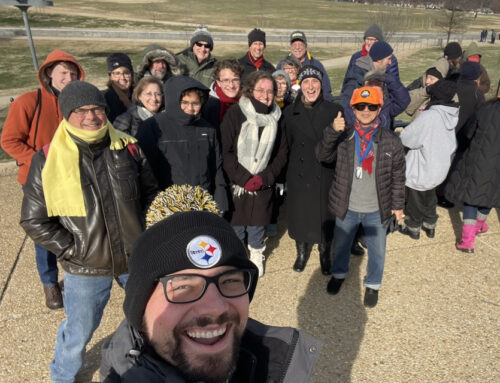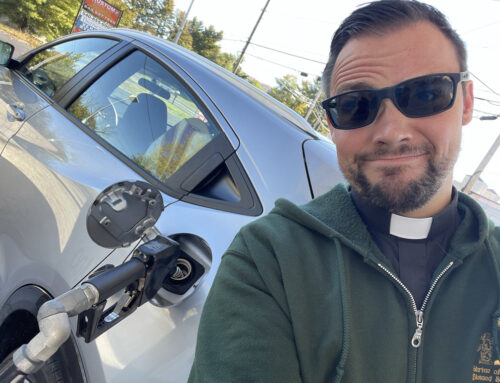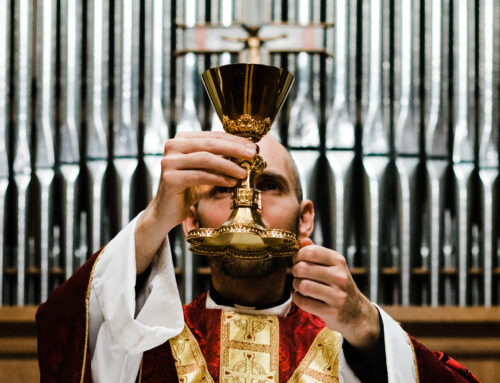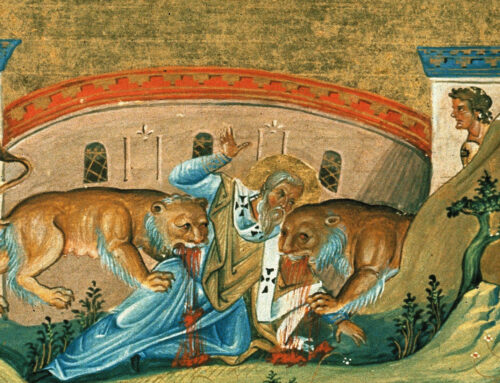Just yesterday afternoon, as the 5:30 Saturday vigil mass was in progress, I happened to be walking around the church, praying my rosary — and I caught a glimpse inside the church.
What did I see?
I saw so many people — young and old, kneeling down, straining forward in their pews in prayer — masks covering half their faces — with this forest of scaffolding surrounding them. And I thought to myself:
This is beautiful.
The Church is just beautiful.
You guys are going to what seems for a lot of people to be extreme, inconvenient, unwise — even absurd! — lengths to physically, emotionally, and spiritually be here at Mass. You’re being asked to overcome and ignore so many kinds of distractions, so many pressures, and so many excuses in order to show up.
And here you are!
That’s beautiful.
But why do we bother? Why are we willing to go through so much? Why don’t we just call off mass until after this restoration work is all finished? Why not just offer the livestream, keep things simple… you all can just stay at home, curl up on your couch with a cup of coffee…the kids can play with their toys without bothering anyone. Wouldn’t that be a whole lot easier? Why go through all this trouble?
The answer, I believe, is in our Gospel passage today:
There we hear Jesus say this: “Why are you troubled? And why do questions arise in your hearts? Look at my hands and my feet, that it is I myself. Touch me and see, because a ghost does not have flesh and bones as you can see I have.”
That’s why we go through so much hassle and trouble to be here at Mass — Jesus Christ has flesh and bone.
And so, we show up, flesh and bone, week in and week out, to worship God the Father, through God the Son, in God the Holy Spirit.
First and foremost, it’s what God deserves — but it’s also what makes us human: We desperately need this kind of in-person, in-the-flesh communion with God. And that is ONLY available in Jesus Christ, who came in the flesh, died in the flesh, and then rose in the flesh.
It didn’t have to be this way…
After dying on the Cross, Jesus could have just spoken to his apostles with a loud booming voice from Heaven — “Heyyy! It’s ok, guys. Don’t worry! I’m still alive! But you know — in a super spiritual sort of way or something…”
But no!
He doesn’t do that! Instead, He shows up. He comes to his disciples in flesh and bone! This is not a mirage. This is not a psychological or visionary experience that all the disciples happen to have at the same exact time. Jesus is really, truly standing in their midst:
“It is I myself! Touch me and see. A ghost does not have flesh and bones.”
The Resurrection appearances are not the first time we’ve heard this sort of thing from the Lord. Remember when Jesus’ disciples were rowing all alone out there on the sea of Galilee, and Jesus came walking towards them on the waters. They cry out in fear — “Look! It’s a ghost!” And Jesus reassured them in the same way that he does now: “No! I’m not a ghost. It’s me! You know me! Don’t be afraid.”
Isn’t that comforting? Jesus speaks to his friends — he speaks to us! — with words of encouragement and strength: “Look! I’m not a nebulous ghost. I’m solid, just like you are! I’m the Word made flesh… I have weight. When I step on this good earth — earth that I created — I leave a footprint! When I reach out to heal you, you can feel the strength in my hands.”
In the early Church, there were some people who denied this belief.
A group called the Docetists doubted that God the Son really, truly did come down to earth in flesh and bone. They thought maybe what they were seeing in Jesus was just some purely spiritual experience — that he just “seemed” to be flesh and bone.
That’s what the word “Docetism” means — “to seem” — Jesus only “seemed human.” The Docetists couldn’t believe that God Himself would so lower himself to really become man. According to them, what they saw on Good Friday was a really good spiritual acting job on God’s part. It didn’t have the full weight of what the Catholic Church proclaims:
That in Christ, God suffered!
Unfortunately, there’s a growing trend — and perhaps it’s even the majority view these days — that claims a similar sort of thing as the Docetists, but it has a different, more attractive slogan.
You’ve heard it before, and probably way too often:
“I’m spiritual… but not religious.”
The “spiritual but not religious person” wants Jesus to be a ghost. They would like Christ to stay distant and ambiguous — they want him to be a hazy, super-spiritualized, vague sort of character who never actually shows up. They would feel much more comfortable if this event of the Resurrection was a kind of mythical mirage — a ghostlike hologram.
But that’s not the story that the gospels tell.
No — by all accounts, the Resurrection of Jesus Christ from the Dead is a concrete, public act of God. It’s an in-your-face revelation. It’s visceral, tangible, there’s nothing vague or ghostly about it. Jesus invites His disciples to literally touch his resurrected, glorified body for proof that he had substance. He eats a piece of baked fish right in front of them!
So why would someone want to be spiritual-but-not-religious anyways?
Well — probably because a vague, ambiguous God doesn’t place any real demands on you. A pale, ghostlike mirage isn’t something you have to reckon with as you make daily decisions.
You can have a nice, safe, emotional experience with a distant god… and he will happily leave you alone when you get tired of him. As CS Lewis said of this impersonal Life Force-type god: You get “all the thrills of religion and none of the cost!”
The story of the Resurrection stands in direct contradiction to such a small and insignificant God. Our proclamation that Jesus is alive is a brutally real statement. It’s a visible claim that has meat!
It’s the sort of Truth that would inspire Peter, an uneducated fisherman, to boldly and courageously stand up in front of the same people who just crucified Jesus and say:
“You denied the Holy and Righteous One and asked that a murderer be released to you. The author of life you put to death, but God raised him from the dead. Of this, we are witnesses!”
St. Peter wouldn’t put his life on the line like that… for a ghost. No, Peter and all of the apostles knew that Jesus Christ, risen from the dead, was real, living, glorified flesh and bone. And they knew that this fact changed EVERYTHING.
Joseph Ratzinger, who went on to become Pope Benedict XVI once wrote that “The Incarnation (and subsequently the Death and Resurrection) of the Word means that God wants to come to men through men.” Or to put the same thing another way — the Incarnation means that God wants to come to us through flesh and bone!
This has huge implications. Because Jesus didn’t take on flesh and bone just to become a ghost again. He promised us: “Behold, I am with you always, even to the end of the ages.”
How so?
His Body the Church.
We believe that Jesus established a visible, flesh and bone Church — with visible, tangible, flesh and bone sacraments that give us access to divine life!
Because Jesus is risen, flesh and bone, the Sacraments are effective:
- When a person goes down flesh and bone into the waters of Baptism, sin is put to death, original sin washed, and new life is really given!
- When a priest anoints that flesh and bone sick person in the hospital, healing and forgiveness really happens!
- When you come, flesh and bone into the confessional and tell your sins to a flesh and bone priest — they are REALLY forgiven!
- When a flesh and bone groom says yes to his flesh and bone bride in Holy Matrimony, they really do become one flesh!
- When a flesh and bone young man lays facedown on the cold hard marble at his Ordination, and has the bishop’s flesh and bone hands are really laid on his head — He really becomes a priest forever!
And in the Sacrament of Sacraments, the Most Blessed Sacrament itself — the Holy Eucharist — Jesus Christ really comes, flesh and bone, to dwell in us. He is broken for us. When we look upon the Sacred Host, we look upon the Resurrection. When we receive the Sacred Host, we’re really nourished, body, soul, and mind. Christ’s words are REAL for us — “Unless you eat my flesh and drink my blood, you have no life within you.”
Without all this, we fall very quickly into the category of “spiritual but not religious.” A disembodied faith, a faith with no flesh and bones, an invisible, hyperspiritualized, private church is one that does not last and does not matter. It falls apart. It’s easy to ignore and overlook.
Only in Jesus Christ, raised flesh and bone, can we have true faith, certain hope, and perfect love.
“Why are you troubled?” Jesus asks us — “And why do questions arise in your hearts? Look at my hands and my feet, that it is I myself. Touch me and see, because I have flesh and bones.”




